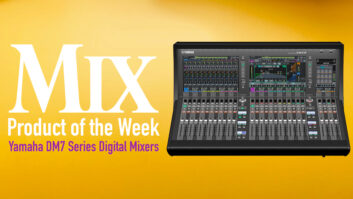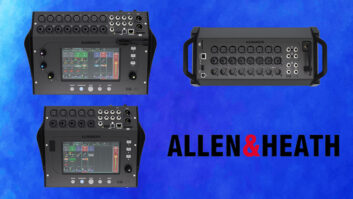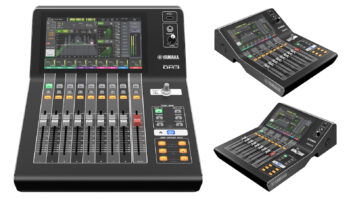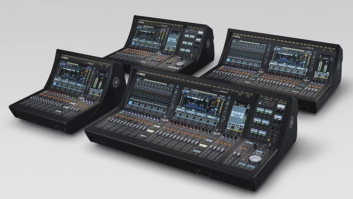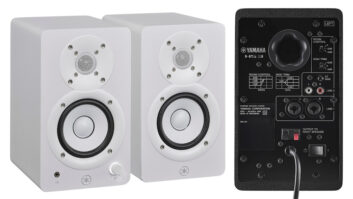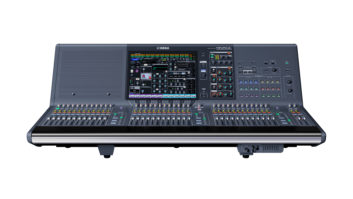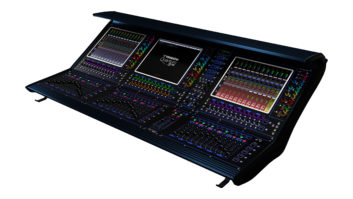Yamaha emerged as a leader in high-end live sound mixing with its digital offerings long before many stalwart analog-centric live console companies dipped their toes in the digital pool. As such, it created now-standard ways of working for many live sound engineers that bought into the Yamaha camp and began specifying the company’s desks from premier live sound firms handling the world’s biggest tours.
The TF Series falls somewhere between Yamaha’s top-tier PM Series and its non-touch enabled digital desks; with a seasoned operator, it can more simply provide world-class results and is remarkably enhanced by today’s consumer-influenced GUI trends. Each TF Series desk is centered on a small touchscreen surrounded by tactile controls. I didn’t know what to expect upon first glance, but upon powering up and giving it some multichannel input, I quickly realized that this review was going to be an easy-going pleasure.
The TF Series are all-enclosed digital mixing solutions for today’s varied multichannel audio mixing needs. Applications range from mid- to large-venue installs, mid-level touring and sophisticated houses-of-worship (HOW) environments. As such, users will find most of what they need, and perhaps more, within TF Series feature sets.
There are three tiers of TF Series mixers: 32-, 24- and 16-100mm motorized fader versions with 32, 24 and 16 recallable D-PRE mic/line preamps, respectively. They feature 48, 48 and 40 inputs, respectively (40, 40 and 32 mono with 2 stereo plus 2 return) and 20 aux busses. 16 XLR outputs are provided within each TF Series mixer. Each TF includes eight effects plus 10 GEQ DSPs and 32 x 32 recording/playback functionality (via USB 2.0 on Mac/PC OS) with stereo channel recording straight to USB HD or SSD, and likewise playback. Other I/O include an iOS-purposed USB port, Ethernet connection for comprehensive networking needs, an expansion slot (for Dante expansion cards, for example), and a rear-panel USB port for multichannel DAW I/O. TF Series desks operate at 48 kHz and various Yamaha outboard and card I/O options are available.
The TF’s TouchFlow Operation is where it really gets interesting. There is a litany of available proprietary functions when it comes to processing within a TF via its 7-inch wide multicolor, multi-touch UI. These begin with Touch & Turn precision adjustments for EQ and other parameters; useful visual overview settings; 1-knob comp and 1-knob EQ parameters; automated Gain- Finder input signal feature; Quick- Pro presets with gain, EQ and compressor- based parameters; two-scene memory banks; many organizational features; and TF Editor, TF Stage- Mix and MonitorMix remote/wireless mix capabilities for iOS. Regarding the TF’s QuickPro presets, TF Series development principal John Schauer explained to me, pre-review, that the TF features tech-based “short cuts” from microphone manufacturers such as Audio-Technica, Sennheiser and Shure, giving the user a trustworthy leaping point for signal processing, no matter the source. Like the rest of its parameters, I found these very logically adjusted via its smooth touch panel surrounded by useful physical controls.
With a snake-full of XLR mic inputs, I was up and running with the review unit—a 24-fader TF3 ($2,999 street)—in less than a minute. From there and in multiple settings—an outdoor gig of multiple acoustic sound sources; in a HOW with choir, pastoral and youth band inputs; and a club gig with multiple acts—I found the TF3 quick to learn and easy to use on the fly. As a matter of fact, for the preliminary outdoors gig, I didn’t even crack the enclosed Quick Guide or refer to more in-depth console documentation found online; I simply powered up, input signal and pecked around on the touchscreen a bit until I was comfortable with the TF’s easy workflow. After my live sound applications, I used the TF3 to mix some pre-recorded live tracks (via Cymatic Audio uTrack 24) with much success, further illustrating the TF Series’ potential flexibility in multipurpose installations like HOWs, municipal theaters and so on.
TF Series processing can be deep and wide as it’s packed with processing power. Most needed features are within a range of “one knob” simplicity, sufficient for near-novice needs as well as seasoned veterans’ preferences; as such, users at either extreme can be pleased. I must admit that there are a couple of parameter adjustments I had to look up, rather than find intuitively; to me, it was comfortably within the normal range of proprietary pro-audio electronics, though still more intuitive than most I regularly find in my work. For example, the StageMix for iOS User’s Guide explained its wireless network settings quite well; there I also found its panning and color coding features, among others, to be very simple functions. After a day or two of mixing some prerecorded multitracks, I felt I had a very solid grasp of what the TF Series can do.
I found musician reactions to the TF Series notable, too. Most that experienced the TF3 found its work surface nearly as intuitive as I did, primarily pointing to the logical flow of its touch OS. Comparatively, there are many other touch-centric digital mixers on the market today; of those I and my musical colleagues have personally auditioned, the TF is in the top tier based on sound quality, capability and ease-of-use, whether based on third-party tablet OS or proprietary OS technology. There are some great products on the market in this category, so I believe that’s saying a lot.
The TF Series is a culmination of numerous Yamaha technologies centered on a logical, user-friendly proprietary OS. In most applications, it’s a complete live sound front end, all enclosed in one piece. I found most operations to be intuitive and had most of what I needed for general “pro grade” live sound results at my fingertips. Best of all, it’s a great-sounding desk—no doubt enhanced by third-party participation in the presets and carefully set parameters—and is built to withstand beatings on the road.
When it’s easy to find audio processing in nearly every device we carry today, it’s refreshing to have an all-enclosed touchscreen-based mixing solution. I love and rely upon my tablets and smart devices, yet when it’s time to mix, the multitasking benefits of consumer devices can usually become a distraction—for me, at least. Here, Yamaha has created a proprietary mix surface with just enough of a learning curve to place its users in the moment and plenty of evolved tools to sculpt sound sources.
Yamaha Pro Audio
yamahaproaudio.com
